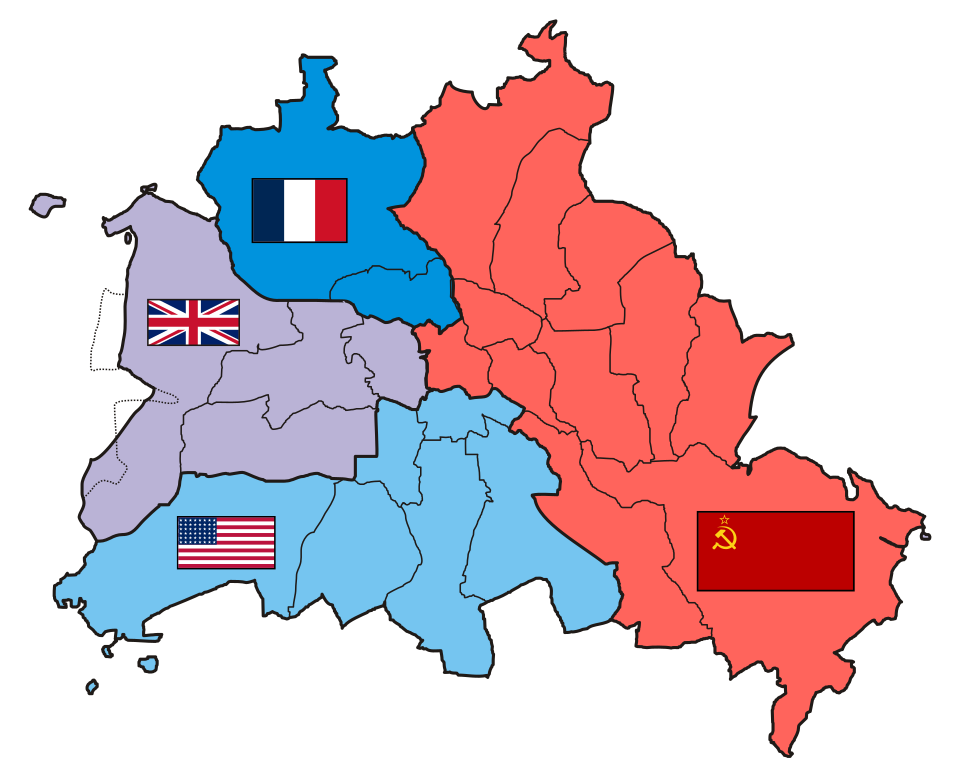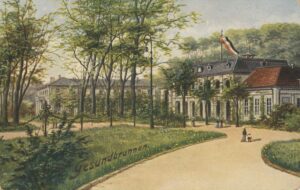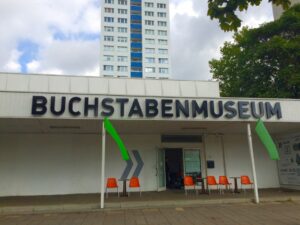The Soviet Shadow: Berlin’s Eastern Occupation Zone (1945-1990)
Call me strange, but I always found those iconic 1945-era images of the red flag of Stalin’s Soviet Union floating over the ruins of Hitler’s capital to be especially haunting, bringing to mind not just the high tragedy of the era, but also the power that rapid and radical change wields over the minds of humans.
Just imagine what the inner dialogue of Berliners must have been in those immediate post-war years. When not dominated by thoughts of survival, many people must have reflected on the how upturned their world had become. Regardless of their degree of support for Hitler, for twelve years (more, if you include the propaganda the party sent out to the public before they took power), the German people had been fed a steady diet of anti-communist hate messaging. They had their ears filled with the notion that communism was the greatest danger facing humankind and only the Nazi party could save them. Now, that red flag floated victoriously above the ruins of that world, as it would for many decades to come, decades that would reshape the German capital’s physical landscape and the lives – both inner and outer – of its residents.

Not Just the DDR: Understanding the Soviet Zone of Occupation
Many people today mistakenly conflate the Soviet occupation zone with the German Democratic Republic (Deutsche Demokratische Republik or DDR), but they weren’t the same thing. After Germany’s defeat in 1945, the Allies divided both Germany and Berlin into four occupation zones. The Soviet zone encompassed the eastern part of Berlin, while the western sections were administered by the Americans, British, and French.
The Soviets, due to their massive losses and to the fact that they had borne the brunt of the war on land, were awarded the city center and the bulk of the worker’s districts and the factories, whatever remained of them anyway. The Western allies got the bulk of the parks and the more upscale residential sections of old Berlin.
The DDR (East Germany) was established in 1949 as a separate socialist state within the Soviet occupation zone of Germany. While the DDR eventually governed East Berlin as its capital, Soviet military authorities maintained a significant presence and influence. Think of it as layers of authority: the Soviet military occupation provided the foundation upon which the East German state was built, but the Soviets retained ultimate control over major decisions affecting their security interests.
The Soviet Presence: Key Moments
From the beginning, the Soviets established a strict military administration which is hardly surprising in light of the horrors of the war that had been unleashed on them in 1941. At first, they focused on demilitarization and denazification, as well as grabbing as many German scientific researchers and equipment as they find, so the Western allies didn’t get their hands on them first. The falling out between the Eastern and Western allies began almost immediately.
Unlike in the western zones, the Soviets quickly dismantled industrial machinery as war reparations, leaving East Berlin with a significant economic disadvantage, which ended up lasting decades. The Soviet relationship with their East German communist brethren was always a balancing act between revenge and mistrust on the one hand, and brotherly socialist feelings on the other. The post-war era certainly created odd bedfellows, let’s put it that way.
The 1953 Uprising
On June 16-17, 1953, worker protests against increased labor quotas erupted in East Berlin and spread across East Germany. As demonstrations grew, Soviet authorities declared martial law to help out their flailing East German comrades. T-34 tanks rolled through East Berlin’s streets once again, and Soviet troops opened fire on protesters. The swift and brutal suppression left dozens dead and hundreds wounded, sending a clear message about who ultimately held power in East Germany.
Checkpoint Charlie and Cold War Tensions
In October 1961, just months after the Berlin Wall’s construction, which the Soviets had authorized, American and Soviet tanks faced off at Checkpoint Charlie. After East German guards began restricting the movement of U.S. diplomats, American tanks took position at the crossing point. The Soviets responded by deploying their own tanks just meters away. For 16 tense hours, the world held its breath as the Cold War threatened to turn hot. Finally, both sides withdrew simultaneously, having narrowly avoided catastrophe.
The Peaceful Revolution and Withdrawal
By 1989, Mikhail Gorbachev’s policies of glasnost and perestroika had weakened the Soviet Union’s grip on its satellite states. When mass protests erupted across East Germany in autumn 1989, Soviet troops remarkably remained in their barracks. Gorbachev refused to use military force to prop up the communist regime, effectively giving East Germans the space to peacefully bring down the Wall on November 9, 1989.
After German reunification in October 1990, approximately 338,000 Soviet troops remained in what had been East Germany. The last Soviet forces left Berlin in 1994, closing a chapter that had begun 49 years earlier.
Soviet Footprints: What Remains Today
You can still visit some of the old Soviet sites in the city today. Because the Soviet sector was the largest, there are more of them to see than in any one of the West’s sectors. They’re also, at least in my view, the most interesting.
Soviet War Memorials
Berlin hosts three major Soviet war memorials, each with its own character:
1. Treptower Park Soviet War Memorial – The largest and most impressive Soviet memorial outside Russia, this sprawling complex honors the 80,000 Soviet soldiers who died during the Battle of Berlin. Dominating the site is a 12-meter bronze statue of a Soviet soldier holding a German child while crushing a swastika underfoot. Flanking the central area are 16 stone sarcophagi, each decorated with relief carvings and inscribed with quotes from Stalin. Of all the sites in Berlin, this is the one that feels most like being in Russia itself. Go in the evening, when visitors are few – time and place seem to warp at bit.
- Address: Puschkinallee, 12435 Berlin
- Open daily: free admission
2. Soviet War Memorial Tiergarten – Located near the Brandenburg Gate, this memorial features a colonnade and two T-34 tanks which fought in the Battle of Berlin. A large bronze statue of a Soviet soldier dominates the ensemble. It was built just after the war, when the Tiergarten had been blasted out of existence, and dominated the surrounding landscape. This is a memorial which expressed conquest and domination, and its central location was no mistake.
- Address: Straße des 17. Juni, 10557 Berlin
- Open daily: 24 hours, free admission
3. Soviet War Memorial Schönholzer Heide – The most somber of the three memorials, this site in northern Berlin contains the graves of about 13,000 Soviet soldiers. Less monumental than Treptower Park but equally moving, its central feature is a grieving Mother Russia statue surrounded by burial mounds marked with simple stones.
- Address: Germanenstraße 1-2, 13156 Berlin (Pankow)
- Open daily: free admission
Sites of Surrender
The modest Schulenburgring 2 apartment in Berlin-Tempelhof marks where General Weidling, Berlin’s defense commander, surrendered the city to the Soviets on May 2, 1945. Though just a residential building today with a small plaque, it represents the moment Berlin passed into Soviet hands and makes an interesting off-the-beaten track stop.
- Address: Schulenburgring 2, 12101 Berlin-Tempelhof
- Note: This is a private residence with only a commemorative plaque outside
More significant is the German-Russian Museum in Karlshorst, housed in the former officers’ mess where Nazi Germany’s unconditional surrender was signed on May 8, 1945. The surrender room is preserved exactly as it was that night. The museum chronicles the German-Soviet war with remarkable balance, neither glossing over Soviet suffering nor sanitizing the Red Army’s actions during its advance into Germany. If you see one Soviet site in Berlin, make it this one.
- Address: Zwieseler Straße 4, 10318 Berlin
- Website: www.museum-karlshorst.de
- Open: Tuesday to Sunday, 10:00 am – 6:00 pm
- Admission: Free
Former Soviet Facilities
Next to the Karlshorst museum once stood the KGB headquarters for all of East Germany. Though the main buildings have been redeveloped into housing, some original structures remain. The sprawling complex once housed thousands of intelligence officers and served as the nerve center for Soviet espionage operations in Germany.
- Address: Adjacent to the German-Russian Museum in Karlshorst, to the left as you face the museum house.
South of Berlin near Wünsdorf-Waldstadt was «Little Moscow,» the largest Soviet military base outside the USSR. This massive complex housed up to 75,000 Soviet personnel. Today, visitors can explore abandoned officer housing, a swimming pool, theater, and even a nuclear bunker, all slowly being reclaimed by nature. Lenin’s statue still stands amid the decay, watching over his crumbling empire. Very nearby, incidentally, were the headquarters of the Wehrmacht during WW2, which you can visit by guided tour.
- Address: Wünsdorf-Waldstadt, 15806 Zossen
- Website: www.buecherstadt.com/en/bunker-tours
- Tours: Available in English and German, registration required
- Admission: €15-35 depending on tour package
The Soviet Embassy
The massive Soviet Embassy on Unter den Linden remains one of Berlin’s most imposing buildings. Completed in 1951 in the «wedding cake» style favored by Stalin, this fortress-like structure served as the Soviet Union’s diplomatic headquarters and a symbol of its power in East Germany. Now the Russian Embassy, it continues to dominate its section of Berlin’s historic boulevard.
- Address: Unter den Linden 63-65, 10117 Berlin
- Note: Not open to the public but impressive to view from outside
Another fascinating site is the former Stasi Headquarters in Lichtenberg, now the Stasi Museum. While technically an East German institution, the Stasi was modeled on the Soviet KGB and maintained close ties with Soviet intelligence throughout the Cold War.
- Address: Ruschestraße 103, 10365 Berlin
- Website: www.stasimuseum.de
- Open: Monday to Friday 10:00 am – 6:00 pm, Saturday & Sunday 11:00 am – 6:00 pm
- Admission: €8, reduced €6





